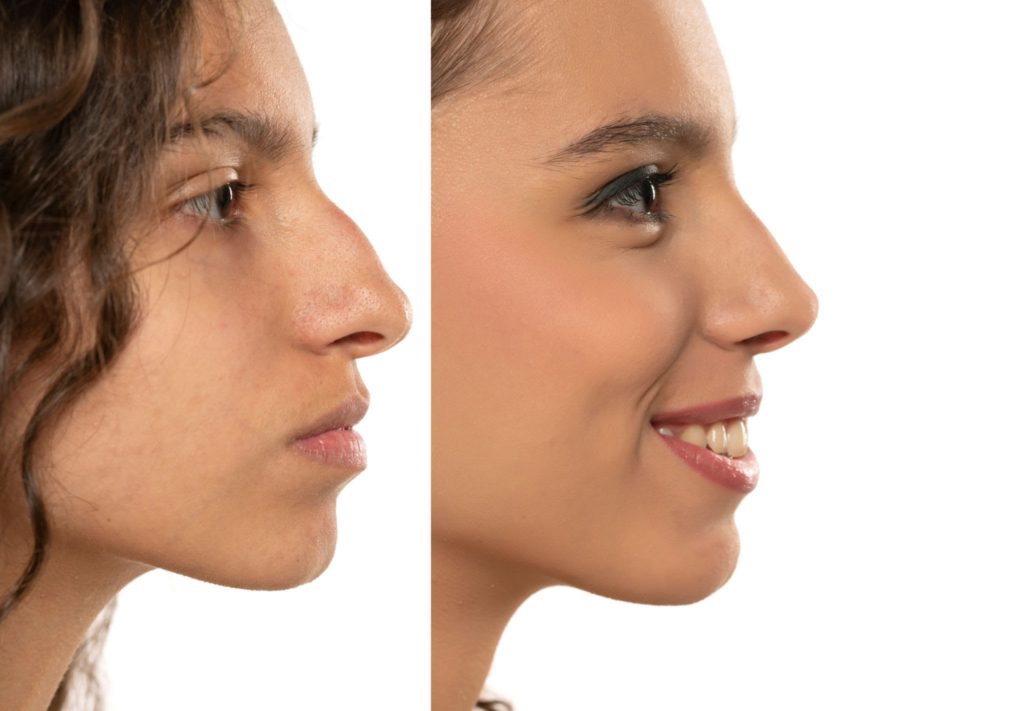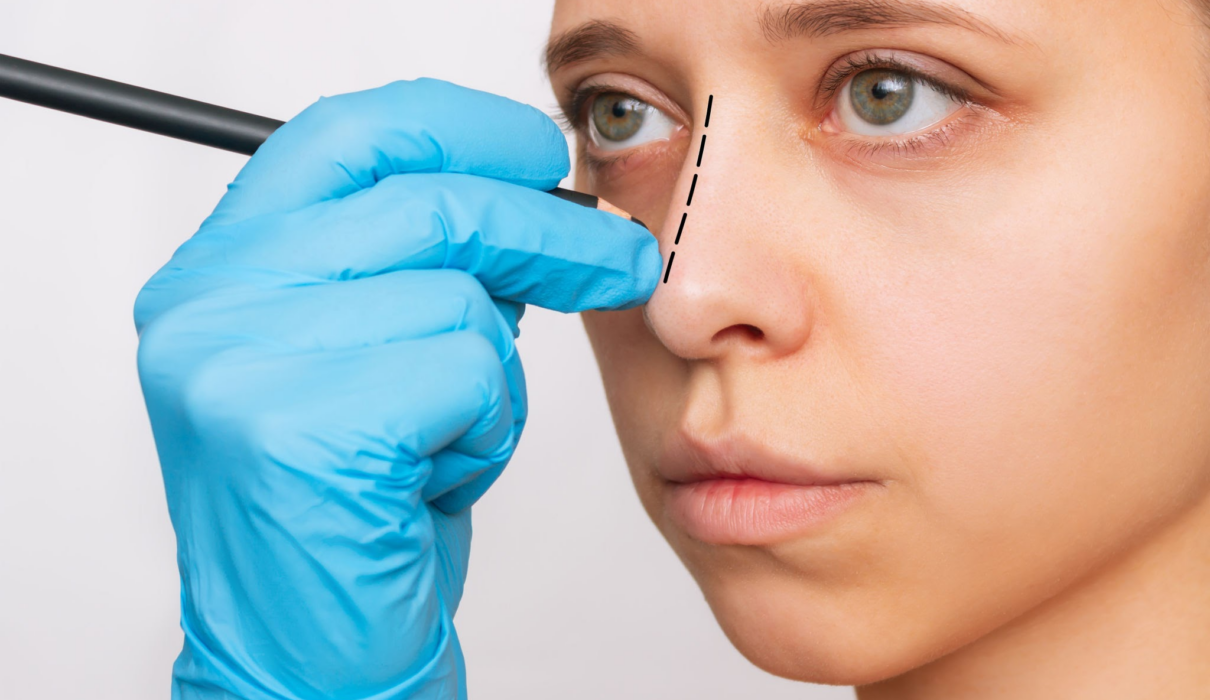For transgender women and individuals seeking facial feminization surgery (FFS), rhinoplasty plays a pivotal role in achieving a more balanced and aesthetically pleasing appearance. Turkey has emerged as a popular destination for FFS, owing to its combination of skilled surgeons, advanced facilities, and competitive costs. But within the realm of FFS rhinoplasty in Turkey, a crucial decision arises: open vs. closed rhinoplasty. Both techniques aim to refine the nose and harmonize it with feminine facial features, but they differ in their approach. This comprehensive guide delves into the intricacies of open and closed rhinoplasty in Turkish FFS, empowering you to make an informed choice for your journey.
Deciphering the Techniques: Open vs. Closed FFS Rhinoplasty
Open Rhinoplasty: Imagine a sculptor meticulously working on a clay bust. In open rhinoplasty, the surgeon creates a small incision across the columella, the narrow strip of tissue separating the nostrils. This approach provides a more unobstructed view of the underlying nasal structures – bones, cartilage, and skin. The surgeon can meticulously reshape these elements to achieve the desired feminine aesthetics. Think of it as having a better vantage point to sculpt a more refined nose.
Closed Rhinoplasty: In contrast, closed rhinoplasty adopts a more subtle strategy. Here, the incisions are strategically concealed within the nostrils, leaving the external appearance virtually untouched. This technique works well for minor refinements or adjustments to the nasal tip. Imagine a skilled potter delicately shaping the clay from within, achieving a beautiful form without visible alterations.

Facial Features and FFS Rhinoplasty Techniques: Finding the Perfect Match
The ideal choice between open and closed rhinoplasty in Turkish FFS hinges on your unique facial characteristics and desired outcomes. Here’s a breakdown to help you navigate:
- Open Rhinoplasty: A compelling choice for individuals seeking significant alterations to the nose, such as:
- Reduction in nasal bridge height: This is a common goal in FFS, aiming to create a smoother and more feminine profile.
- Refining the nasal tip: Open rhinoplasty offers greater precision for sculpting a delicate and upturned tip, often desired for a feminine appearance.
- Narrowing wide nostrils: This technique allows for meticulous reshaping of the alar base (the fleshy part of the nostrils) for a more refined look.
- Correcting nasal asymmetry: Open rhinoplasty provides better access for addressing deviations or imbalances in the nose.
- Closed Rhinoplasty: This approach is well-suited for individuals with:
- Subtle concerns: If your goal is to address minor bumps on the bridge or refine the tip slightly, closed rhinoplasty can deliver excellent results with minimal scarring.
- Strong preference for minimal external incisions: For those seeking a virtually scarless outcome, closed rhinoplasty offers a discreet solution.
Remember, a consultation with a qualified FFS surgeon in Turkey is paramount. They will meticulously evaluate your facial features, discuss your aesthetic goals, and recommend the most suitable technique based on your individual case.
Unveiling the Risks and Recovery: A Look at Open vs. Closed FFS Rhinoplasty in Turkey
Both open and closed rhinoplasty in Turkish FFS are generally safe procedures when performed by experienced surgeons. However, it’s essential to understand the potential risks associated with each:
- Open Rhinoplasty:
- Increased risk of scarring: Due to the external incision on the columella, there’s a slightly higher chance of visible scarring. However, skilled surgeons employ meticulous closure techniques to minimize this risk.
- Longer recovery time: Open rhinoplasty often involves more extensive tissue manipulation, leading to a slightly longer recovery period compared to closed rhinoplasty.
- Closed Rhinoplasty:
- Limited visibility: The restricted view within the nostrils might make it slightly more challenging to achieve very dramatic results.
- Potential for revision surgery: In some cases, closed rhinoplasty may not be suitable for addressing complex nasal concerns, potentially requiring revision surgery with an open approach.
Recovery time in Turkish FFS rhinoplasty varies depending on the technique and the extent of the surgery. Generally, expect swelling, bruising, and some discomfort for the first week or two. Open rhinoplasty might require slightly longer recovery (around 2-4 weeks) compared to closed rhinoplasty (1-3 weeks). However, meticulous adherence to your surgeon’s post-operative instructions is crucial for optimal healing in both cases.
Remember: Transparency is key. During your consultation with the FFS surgeon in Turkey, openly discuss any concerns you have regarding risks and recovery.

The Art of Precision: Surgeon’s Visibility and Manipulation in FFS Rhinoplasty
The surgeon’s ability to visualize and manipulate the nasal structures significantly influences the outcome of FFS rhinoplasty. Here’s how the open and closed techniques differ in this crucial aspect:
- Open Rhinoplasty: This technique offers an unparalleled advantage in terms of visibility. The external incision grants the surgeon a direct, unobstructed view of the entire nasal framework – bones, cartilage, and skin. This allows for meticulous manipulation and reshaping of these elements with a high degree of precision. Imagine a sculptor working with a well-lit and unobstructed view of their clay bust, enabling them to make precise adjustments with their tools.
- Closed Rhinoplasty: In contrast, closed rhinoplasty presents a more limited view. The surgeon relies on instruments and their sense of touch to manipulate the nasal structures from within the nostrils. While skilled surgeons can achieve excellent results with this approach, it requires a certain degree of dexterity and experience to navigate the confined space and achieve the desired outcome. Think of a potter meticulously shaping the clay from within, relying on touch and experience to achieve the perfect form.
Surgeon’s Expertise is Key: Remember, regardless of the technique, the surgeon’s skill and experience are paramount. In Turkish FFS, choosing a board-certified facial plastic surgeon with extensive experience in rhinoplasty, particularly FFS rhinoplasty, is crucial. Their expertise in manipulating the nasal structures, whether with the open or closed approach, will significantly impact the final outcome.
The Importance of Communication: Establishing clear communication with your surgeon is vital. Discuss your aesthetic goals in detail, and don’t hesitate to ask questions about their experience with each technique. A skilled surgeon will be able to explain the advantages and limitations of both open and closed rhinoplasty in the context of your unique case.
Considering Revision Rhinoplasty: If you’ve previously undergone rhinoplasty and are seeking refinement or correction, understanding the visibility aspect becomes even more critical. In revision rhinoplasty, scar tissue can be a challenge. The open approach might be preferable in such cases, as it provides a clearer view of the underlying structures and allows for more precise manipulation of scar tissue.
Remember: When it comes to FFS rhinoplasty in Turkey, choosing a surgeon who prioritizes meticulous technique, clear communication, and a focus on achieving your desired outcome is paramount.
The Financial Lens: Navigating Costs of Open vs. Closed FFS Rhinoplasty in Turkey
While cost is a natural consideration when exploring FFS rhinoplasty in Turkey, it shouldn’t be the sole deciding factor. Here’s a breakdown of the financial landscape:
- Open vs. Closed Technique: Generally, open rhinoplasty carries a slightly higher price tag compared to closed rhinoplasty in Turkey. This reflects the increased surgical complexity, often involving more extensive tissue manipulation and potentially a longer operating time.
- Experience Matters: The surgeon’s expertise and reputation significantly impact the cost. Highly qualified FFS surgeons with extensive experience in rhinoplasty, particularly FFS rhinoplasty, will naturally command a premium compared to less experienced surgeons. However, remember that investing in a skilled surgeon can save you from potential complications and the need for revision surgery down the line, ultimately proving more cost-effective.
- Facility Fees: The chosen hospital or surgical facility in Turkey can also influence the overall cost. Reputable facilities with advanced technology and experienced staff will likely have higher fees compared to less-equipped centers. However, prioritizing a well-established facility ensures your safety and comfort during the procedure.
Beyond the Price Tag: Here’s what to consider when evaluating the cost of FFS rhinoplasty in Turkey:
- Consultation Fees: Some surgeons offer free consultations, while others may charge a fee. This initial meeting is crucial for discussing your goals, understanding the procedure, and getting a personalized cost estimate.
- Hidden Costs: Factor in potential additional expenses like pre-operative tests, medications, post-operative care supplies, and travel costs (if applicable).
Transparency is Key: During your consultation with the FFS surgeon in Turkey, have an open conversation about the cost breakdown. Don’t hesitate to ask for a detailed quote outlining the surgeon’s fees, facility charges, and any anticipated ancillary costs.
Remember: While cost is a factor, prioritizing an experienced surgeon, a reputable facility, and a technique that aligns with your needs will ultimately deliver the best value for your investment in FFS rhinoplasty.
The Weight of Experience: Why Surgeon’s Expertise Matters in Choosing Between Open and Closed FFS Rhinoplasty in Turkey
When navigating the decision between open and closed FFS rhinoplasty in Turkey, a crucial factor often takes center stage: the surgeon’s experience. While the technical nuances of each approach are important, a skilled surgeon’s expertise can significantly influence the outcome, regardless of the chosen technique. Here’s why:
- A Masterful Hand: FFS rhinoplasty, particularly open rhinoplasty, demands a high level of surgical finesse. An experienced FFS surgeon in Turkey will possess a deep understanding of facial anatomy, specifically the delicate structures of the feminine nose. Their years of experience translate into a masterful hand, allowing them to manipulate the nasal bones, cartilage, and skin with precision, ensuring a natural-looking and aesthetically pleasing result.
- Navigating Complexity: Open rhinoplasty often tackles more complex nasal concerns, such as significant bridge reduction, tip refinement, or addressing asymmetry. A seasoned surgeon will have encountered and addressed a wide range of challenges during their career. This experience equips them to confidently navigate the complexities of each case and make crucial decisions during surgery to achieve the desired outcome.
- The Art of Refinement: Even with closed rhinoplasty, a surgeon’s experience plays a vital role. While this approach is generally suited for subtler modifications, a skilled surgeon can achieve beautiful results through meticulous manipulation within the nasal cavity. Their experience allows them to anticipate potential challenges and make delicate adjustments to achieve the desired aesthetics.
- The Value of Anticipation: An experienced FFS surgeon can anticipate potential complications and take proactive measures to minimize their risk. Their knowledge of potential anatomical variations and how they might affect the outcome allows them to adapt their approach during surgery, ensuring a smoother and more predictable recovery process.
- Minimizing Revision Surgery: Revision rhinoplasty, while sometimes necessary, can be a complex and less predictable procedure. Choosing an experienced surgeon for your initial FFS rhinoplasty in Turkey significantly reduces the likelihood of needing revision surgery down the line. Their expertise can help ensure a successful outcome from the first procedure.
Remember: When considering FFS rhinoplasty in Turkey, prioritize finding a board-certified facial plastic surgeon with extensive experience in rhinoplasty, particularly FFS rhinoplasty. Their expertise is an invaluable asset, ensuring a safe, effective, and aesthetically pleasing outcome. Don’t hesitate to research surgeons, review their qualifications and experience, and ask them about their specific approach to FFS rhinoplasty during your consultation.
The Bottom Line: While both open and closed techniques have their merits in FFS rhinoplasty, a surgeon’s expertise is the cornerstone of achieving your desired outcome. A skilled surgeon can leverage their experience to maximize the benefits of either approach, ultimately delivering a beautiful and natural-looking feminine nose.

Cultural Considerations and Aesthetic Preferences: A Look at FFS Rhinoplasty in Turkey for Transgender Individuals
For transgender women seeking facial feminization surgery (FFS) in Turkey, rhinoplasty plays a pivotal role in achieving facial harmony and a more congruent feminine appearance. However, cultural considerations and aesthetic preferences can influence the choice between open and closed rhinoplasty techniques. Here’s a closer look:
Understanding Cultural Beauty Standards: Beauty ideals can vary across cultures. In some Western countries, a very defined and upturned nose might be considered a hallmark of feminine beauty. However, in Turkey and other parts of the world, a more subtle and natural-looking approach to rhinoplasty might be preferred. This can influence the choice of technique.
- Open Rhinoplasty: While open rhinoplasty allows for significant sculpting and refinement, it might not be the ideal choice if a very subtle result is desired. The visibility it offers can sometimes lead to a more sculpted or “Westernized” appearance, which might not align with everyone’s aesthetic goals.
- Closed Rhinoplasty: For individuals seeking a more natural and less dramatically altered nose, closed rhinoplasty can be a compelling option. This technique excels at achieving subtle refinements that blend harmoniously with existing facial features.
Open Communication is Key: During your consultation with the FFS surgeon in Turkey, openly discuss your cultural background and aesthetic preferences. Share images of noses you find aesthetically pleasing, and don’t hesitate to ask if a particular technique aligns better with achieving your desired outcome. A skilled surgeon will be able to adapt their approach to cater to your specific goals.
Beyond Ethnicity: It’s important to remember that facial features transcend ethnicity. While some cultural preferences might exist, the ultimate goal is to achieve a nose that complements your unique facial structure and aligns with your personal vision of femininity.
Finding the Right Balance: The key lies in striking a balance between cultural considerations and your individual preferences. A skilled FFS surgeon in Turkey will understand these nuances and guide you towards the technique that best achieves a natural-looking, feminine nose that complements your overall facial harmony.
Remember: Open communication with your surgeon is paramount. Express your aesthetic desires openly, and don’t be afraid to ask questions about how cultural considerations might influence the choice of technique.
Scars and Secrecy: Unveiling the Scarring Potential of Open vs. Closed FFS Rhinoplasty in Turkey
When considering FFS rhinoplasty in Turkey, a common concern for many individuals is scarring. Both open and closed techniques have implications for scarring, and understanding these differences can be crucial in making an informed decision.
Open Rhinoplasty:
- The Trade-Off: The open approach necessitates a small incision on the columella, the strip of tissue separating the nostrils. While meticulously closed by the surgeon, this incision has the potential to leave a visible scar.
- Minimizing the Mark: However, skilled FFS surgeons in Turkey employ meticulous closure techniques and strategically place the incision to minimize its visibility. Additionally, with time and proper scar care, the scar often fades significantly, becoming barely noticeable.
- Transparency is Key: During your consultation, discuss your concerns about scarring with the surgeon. Ask them about their specific closure techniques and what you can expect regarding scar visibility and care post-surgery.
Closed Rhinoplasty:
- The Allure of Invisibility: The closed technique boasts the advantage of minimal external incisions. All incisions are concealed within the nostrils, leaving the external appearance virtually untouched. This makes closed rhinoplasty appealing for those seeking a scar-free outcome.
- Limitations and Potential Revisions: It’s important to remember that closed rhinoplasty has limitations. The restricted view within the nostrils can make achieving very dramatic results or addressing complex nasal concerns more challenging. In some cases, closed rhinoplasty might not be sufficient, and revision surgery with an open approach might be necessary down the line, potentially leading to additional scarring.
Choosing Wisely: The decision ultimately hinges on your priorities. If achieving a virtually scar-free outcome is paramount, and your desired modifications are subtle, closed rhinoplasty might be a suitable choice. However, if you require significant nasal refinement or prioritize achieving the best possible aesthetic outcome, even with a potential for a minimal scar, open rhinoplasty could be the better option.
Remember: Scarring is a natural part of the healing process. While open rhinoplasty carries a slightly higher risk of visible scarring, a skilled surgeon can significantly minimize its appearance. Open communication with your FFS surgeon in Turkey is key. Discuss your concerns about scarring and your aesthetic goals to determine the technique that best aligns with your priorities.
Beyond the Scar: It’s important to remember that achieving a natural-looking and aesthetically pleasing outcome should be the primary focus. While minimizing scarring is desirable, prioritizing a skilled surgeon and the technique that best achieves your desired facial harmony is ultimately more important.
The Phoenix Effect: Revision Rhinoplasty and Technique Choice in FFS Rhinoplasty (Turkey)
Even with the most meticulous planning and skilled surgeons, unforeseen circumstances or complications can necessitate revision rhinoplasty following FFS rhinoplasty in Turkey. While not ideal, revision surgery can play a crucial role in refining the outcome and achieving optimal aesthetics. Here’s how the choice of technique (open vs. closed) factors into revision rhinoplasty:
- Understanding the Challenge: Revision rhinoplasty presents a unique set of challenges for the surgeon. Scar tissue formation from the initial surgery can make manipulating the nasal structures more intricate. Choosing the right technique becomes even more critical in this scenario.
- Open Technique’s Advantage: In revision rhinoplasty, the open approach often reigns supreme. The direct visualization it offers allows the surgeon to meticulously assess the underlying scar tissue, identify any discrepancies, and precisely address them. This level of visibility is particularly valuable for ensuring optimal outcomes in revision surgery.
- Closed Technique’s Limitations: While closed rhinoplasty can be a suitable option for primary FFS rhinoplasty in some cases, it might not be the most effective approach for revision surgery. The limited view within the nostrils can make it challenging to navigate the scar tissue and achieve the desired level of precision.
Remember: There’s no one-size-fits-all answer when it comes to revision rhinoplasty. The choice between open and closed techniques depends on the specific reasons for revision and the nature of the existing scar tissue.
Finding the Revision Specialist: When seeking revision rhinoplasty after FFS rhinoplasty in Turkey, prioritize finding a surgeon with extensive experience in revisionary procedures. Their expertise in navigating scar tissue and meticulous surgical techniques are crucial for achieving a successful outcome.
The Importance of Communication: During your consultation for revision rhinoplasty, openly discuss the initial surgery, the concerns you have, and your desired outcome. A skilled surgeon will be able to evaluate your case, recommend the most suitable technique (open or closed) based on your specific needs, and explain the revision process in detail.
Remember: Revision rhinoplasty can be a transformative procedure, offering an opportunity to refine the results of the initial surgery and achieve your desired facial harmony. By prioritizing a skilled revision specialist and open communication, you can navigate this process with confidence.
Beyond Technique: While the chosen technique plays a significant role, remember that a successful revision rhinoplasty hinges on several factors. Choosing a board-certified facial plastic surgeon with extensive experience in revision FFS rhinoplasty in Turkey is paramount. Their expertise, combined with meticulous planning and communication, will pave the way for a positive revision surgery experience.

Breathing Easy: Long-Term Functional Considerations in FFS Rhinoplasty (Turkey)
While achieving a beautiful and aesthetically pleasing feminine nose is a primary goal in FFS rhinoplasty (Turkey), a crucial aspect often takes center stage: long-term breathing function. Here’s a breakdown of how open and closed techniques can influence post-operative breathing:
- Understanding the Balance: A skilled FFS surgeon strives to achieve a perfect balance between aesthetics and function. Ideally, the rhinoplasty procedure shouldn’t compromise your ability to breathe comfortably.
- Open Rhinoplasty: The open approach offers greater control over the nasal structures, allowing the surgeon to meticulously reshape the cartilage and bone without obstructing the nasal airway. In skilled hands, open rhinoplasty can effectively address functional concerns like septal deviations or valve collapse, potentially improving breathing in some cases.
- Closed Rhinoplasty: While closed rhinoplasty is generally a safe procedure, the limited view within the nostrils can pose a slightly higher risk of unintentionally compromising the nasal airway. This is especially true for individuals with pre-existing breathing difficulties.
- Importance of Pre-operative Evaluation: A thorough pre-operative evaluation by the FFS surgeon in Turkey is essential. This evaluation will include a detailed discussion of your breathing habits and any pre-existing nasal concerns. The surgeon will also perform a nasal endoscopy to visualize the internal structures and assess potential airway obstructions.
- Open Communication is Key: During your consultation, don’t hesitate to discuss any concerns you have about breathing difficulties following surgery. A skilled surgeon will explain the potential risks and how they plan to address them during the procedure, regardless of the chosen technique (open or closed).
Beyond the Technique: Here are some additional factors to consider:
- Individual Anatomy: Nasal anatomy varies greatly from person to person. A skilled surgeon will factor in your unique anatomy when performing the rhinoplasty, ensuring optimal aesthetics and breathing function.
- Healing Process: Temporary swelling and congestion are common after FFS rhinoplasty, regardless of the technique. These usually resolve within a few weeks as the healing progresses.
Remember: While both open and closed techniques can achieve excellent aesthetic outcomes, prioritizing a skilled and experienced FFS surgeon in Turkey is paramount. Their expertise in nasal anatomy and meticulous surgical techniques will ensure a successful outcome that optimizes both aesthetics and breathing function.
The Bottom Line: Open communication with your surgeon and a focus on finding a highly qualified professional are key to achieving a beautiful and functional nose following FFS rhinoplasty in Turkey. By prioritizing both aesthetics and breathing function, you can ensure a long-term outcome that enhances your confidence and overall well-being.
We hope you found this article informative and helpful. If you did, please share it with your friends and family who might benefit from it. Also, feel free to leave a comment below and let us know what you think. We would love to hear from you. Thank you for reading, and we wish you all the best.
Follow our blog for more. You can also reach us on our contact page for any questions you may have. Ffs center is an LGBT community friendly organization.
FAQs
1. Can I predict which technique (open vs. closed) is right for me before consulting a surgeon?
While you can’t definitively decide without a professional evaluation, understanding your desired outcome and any pre-existing nasal concerns can offer some guidance. If you seek significant nasal refinements or have breathing difficulties, an open approach might be preferable. However, a consultation with a qualified FFS surgeon in Turkey is vital for a personalized recommendation.
2. How long will the results of FFS rhinoplasty (Turkey) last?
The results of FFS rhinoplasty in Turkey are generally long-lasting. With proper care and avoiding trauma to the nose, the sculpted nasal structure should remain stable for many years. However, natural aging processes can cause subtle changes in the appearance over time.
3. What are some recovery tips to optimize the outcome of FFS rhinoplasty (Turkey)?
Following your surgeon’s post-operative instructions diligently is crucial. These typically involve rest, head elevation, meticulous nasal hygiene, and avoiding strenuous activity. Applying cold compresses to reduce swelling and using prescribed medications are also important. Remember, proper healing is vital for achieving optimal aesthetic and functional outcomes.


